There is new “bad news” from the USA: The statistics now show that in the years 2021 and 2022 sick leave in the USA and thus absenteeism reached new record highs.
And how could it be otherwise, statistics from Germany now show a similar trend. The DAK speaks of the highest sick leave since 1997, the year in which this statistic was introduced.
And this is how it is in the United States right now [1] [2]:
This graph shows the rate of absenteeism due to injury and/or illness among workers aged 25-54.
What is interesting here is the steady decrease in this rate since 2002, which only began to rise slightly again in 2020. The years 2021 and 2022 then showed an almost exponential increase, which of course immediately raised the suspicion that this could be a “corona vaccination” effect, in which the side effects play the decisive role in sick leave.
The next graphic shows the massive increase since 2019 even more clearly. Here the lost working hours due to injury and/or illness are shown:
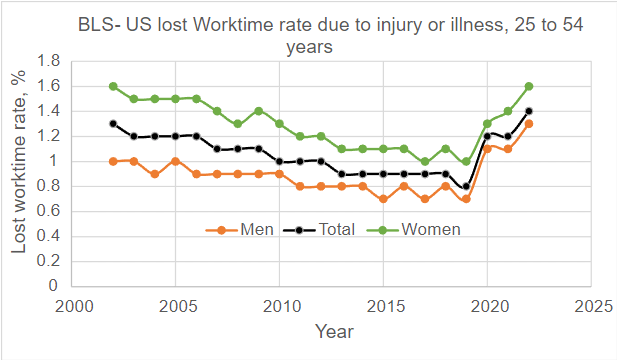
This graphic shows the massive increase in numbers in 2020 compared to 2019. In 2021, the level reached was then maintained. In 2022, there was another massive increase.
The increase in lost working hours in 2020 is likely to be due to the “pandemic” measures (provided that the pandemic-related absences from workplace closures are included here). Can one then attribute the increase in downtime observed afterwards to “vaccination side effects”?
It cannot be ruled out that the gene injections played their part here. After all, a significant proportion of those “vaccinated” have been hit by side effects and worse.
However, there are, especially for women, high values for absenteeism and lost working hours in the period 2002-2012, with a downward trend. In terms of absenteeism, the numbers during that time were in the range of 2022. But there were no “corona vaccinations” back then.
For men, both curves show a clear increase for the last two years, without the previous years being able to show significantly higher values compared to 2022. Could this mean that the gene injections in men might have been the main cause?
If so, then the question arises, why is it obviously different for women? Why are there differences and what are they based on?
By the way: If you are interested in such information, then you should definitely request my free practice newsletter “Independent. Naturally. clear edge.” to:
Germany makes you sick
The “Techniker Krankenkasse” recently published its health report for the year 2022 [3].
When comparing the inability to work for the years 2021 and 2022, it is immediately noticeable that the year 2022 has significantly higher numbers except for one category:
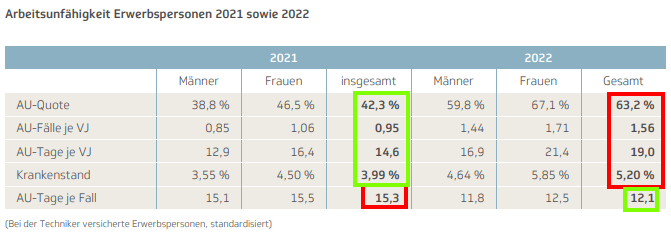
A comparison of the lost days from 2000-2022 looks like this:
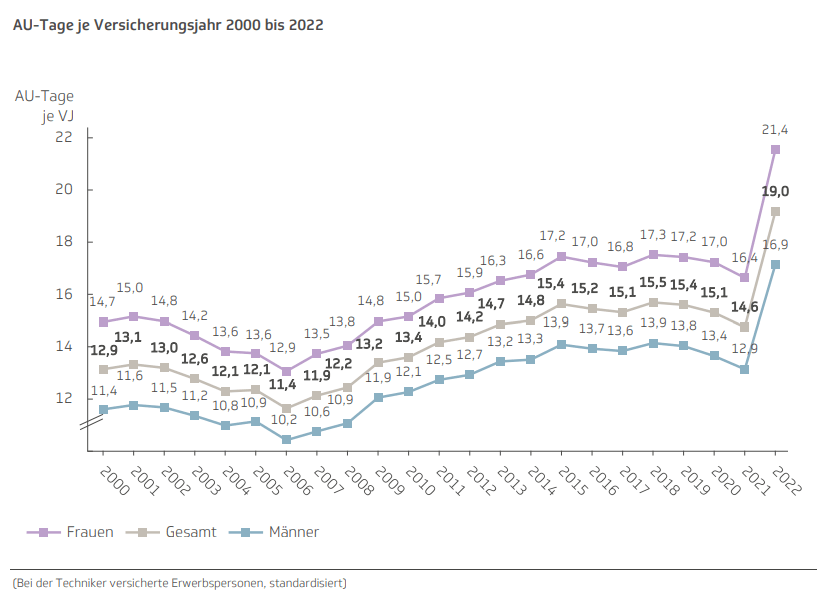
In contrast to the USA, there were no such high values for women in the early 2000s as in 2022. For men, on the other hand, there has been a steady increase in downtime since 2006, which was also observed among women.
As of 2018, there has been a slight decrease for males and females. In 2020, the “pandemic” year, in which the USA recorded a significant increase in numbers, there was a decrease in Germany. How can this discrepancy be explained? Were numbers collected differently here than in the USA?
The massive jump from 2021 to 2022 poses even more puzzles. This jump is so striking that one is almost reflexively inclined to blame gene injections for it. But they were already there in 2021, albeit not as widespread as in 2022. If gene injections are responsible for the loss of work here, then this should have had an impact as early as 2021. Instead, the numbers have decreased slightly compared to 2020 instead of increasing. First of all, this suggests that other factors must be held responsible for the strong increase in 2022.
By the way: If you are interested in such information, then be sure to request my free practice newsletter:
What caused the absences from work?
According to the TK, it is, you can hardly believe it, respiratory diseases that come first. Mental illnesses are in second place [4].
According to the DAK, respiratory diseases (colds and bronchitis) are also the most common cause of absence from work. After there was no more flu in 2020, now the flu seems to be back, right?
And the DAK also reports that Covid-19 is on the rise: In 2021 there were still 22 days of absence per 100 insured persons caused by Covid-19. In 2022 there were 130. Question: So is it true that the Covid-19 “vaccination” does not prevent infections with SARS-CoV-2, but rather seems to promote it? Because a six times higher number of cases in the year when over 70 percent of the population is said to be “immunized” against Covid-19 speaks more for a promotion of the infection process.
The article appeared on the ZDF website. And ZDF wouldn’t be ZDF if it didn’t have a narrative-friendly explanation for this massive increase for 2022. Here the increase in downtime due to respiratory diseases and Covid-19 is explained by the fact that since the beginning of 2022 “the certificates of incapacity for work go directly electronically from the practices to the cash registers“. This would also include cases in the statistics that would otherwise not be recorded, i.e. the number of unreported cases would be lower.
So there are definitely no absences from work that could be attributed to “vaccination side effects”. Because it cannot be what must not be.
After all, the BKK sounded the alarm about this in 2022, as did American insurance companies:
But maybe these side effects are health problems that don’t keep those affected from working? Joking aside…
In the various federal states, the failure rate and the number of days lost varies:
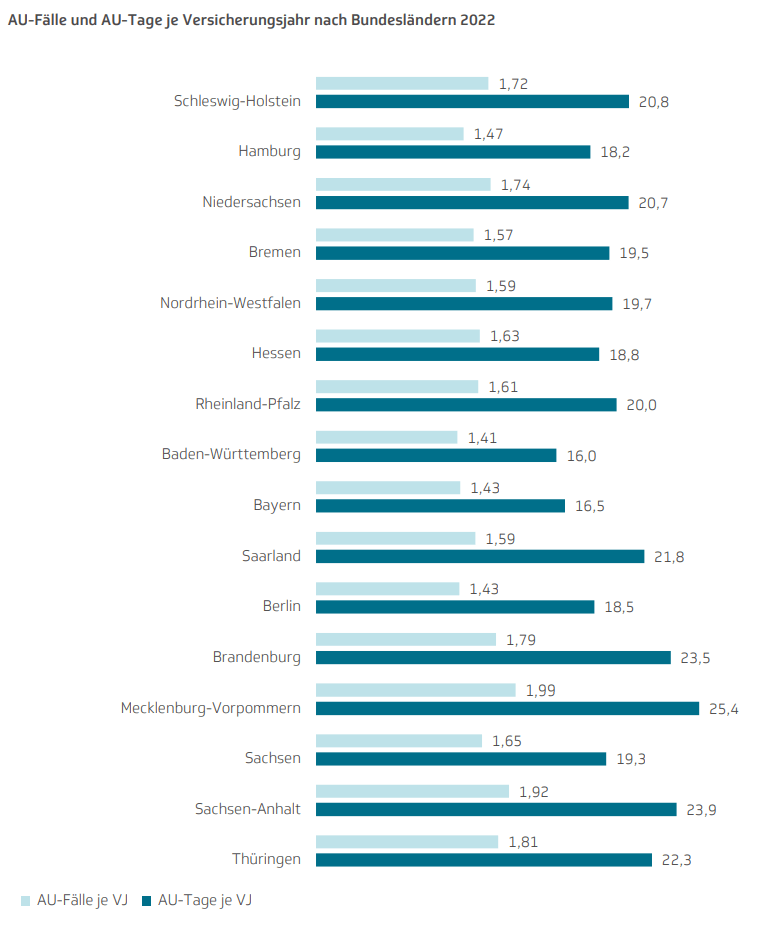
If a clear influence of the gene injections could be observed here, then the federal states with the highest “vaccination rates” would also have to have the highest number of lost days. However, that does not seem to be the case [5].
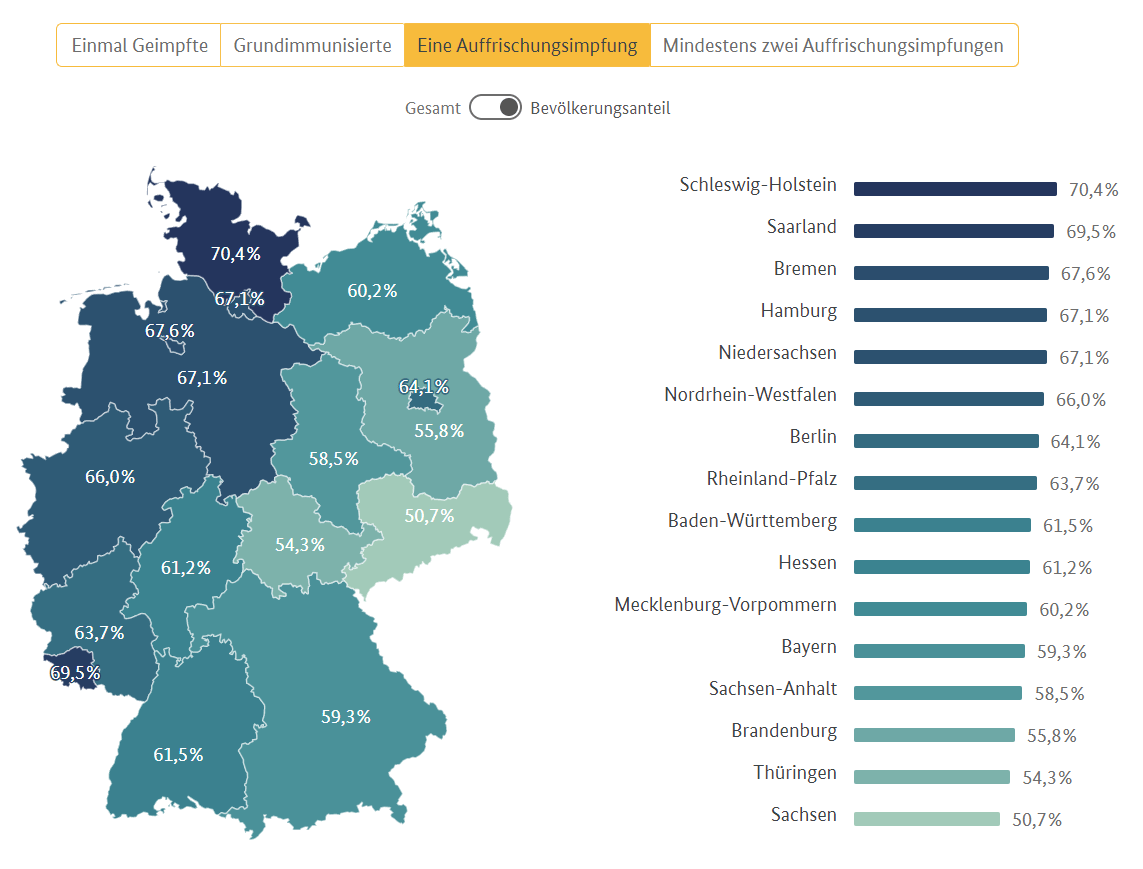
Since the statistics for two “booster vaccinations” contain significantly fewer people than for “one booster vaccination” and “basic immunization”, I decided to compare them with the statistics for “one booster vaccination”. The numbers given here are only slightly below the numbers for the category “basic immunization” and should actually be even clearer if side effects of these “vaccinations” are to be seen. Because the people here have been stung three times instead of twice.
It quickly becomes apparent that there is no correlation between “vaccination status” and inability to work for the countries. Schleswig-Holstein is the leader when it comes to boosters with over 70 percent. And Saxony brings up the rear with over 50 percent.
The two states differ only marginally in terms of absenteeism rates and absentee days (Schleswig Holstein 1.72 and 20.8 versus Saxony 1.65 and 19.3). Baden-Württemberg has the lowest numbers to report here (1.41 and 16.0), but is in the middle when it comes to the number of boosters at 61.5 percent. If there were a correlation here, one would assume Baden-Württemberg to be at the bottom of the list.
By the way: If you are interested in such information, then be sure to request my practice newsletter with the “5 miracle cures”:
Side note: The “5 Miracle Cures” thing is by far the most popular newsletter that my patients love to read…
If not the “vaccination”, then what?
The figures presented here make it difficult to give a reasonably plausible explanation. But they are by no means “proof” that the gene injections play no role here at all.
After all, if gene injections were “safe and effective,” why is there an increase in disease and related disability at all? According to the DAK, even Covid-19 cases have increased significantly. Is this the “proof” of the effectiveness of the “corona vaccinations”?
An article in “Report 24” from July 2022 reported on a chief physician who put the sickness rate among “vaccinated” staff five times higher than among “unvaccinated”. [6]. This should “prove” that side effects of the gene injections may be a contributing factor.
I mentioned that mental illness is number 2. Their causes may only have something to do indirectly with the gene injections. Other causes of mental illness are likely to be found in the absurd “pandemic” measures, in the absurd bans, compulsory masks, school closures, paralysis of public life, etc., which were enforced more or less equally in all federal states.
Even after the end of the “measures”, the emotional burden and the psychological stress did not subside, also caused by the strange, nonsensical discussions and the war cries of the government representatives after the “pandemic”, the economic downturn in Germany, the increasing crime rate, etc.
We have now had three years of constant stress across the board, which is draining the substance of each individual. This is also likely to be an important reason why the susceptibility to diseases has increased to such an extent across countries.
1387 words – €44.43
By the way: If you are interested in such information, then you should definitely request my free practice newsletter “Independent. Naturally. clear edge.” to:
Sources:
- Humanity Project – US Absence rates – Part 1
- ‘These Numbers Look Horrific’: Work Absence Rates Are Off the Charts — And It’s Only Gotten Worse
- Health report – brief overview of absenteeism
- DAK data: 2022 more days off work due to illness – ZDFheute
- COVID-19 Impfdashboard
- Chief physician warns health department: sick leave five times higher for vaccinated staff
Featured Image:
123rf.com – Katarzyna Bialasiewicz
This post was created on April 3rd, 2023.
